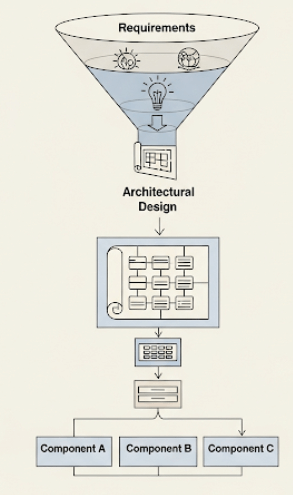- Design Engineering
- Design Process And Design Quality
- Design Concepts
- The Design Model
- Creating An Architectural Design
- Software Architecture
- Data Design
- Architectural Styles And Patterns
- Architectural Design
- Conceptual Model Of UML
- Basic structural modeling
- Class diagram
- Sequence Diagram
- Collaboration Diagrams
- Use Case Diagram
- Component Diagrams
Architectural Design in Software Engineering
Architectural design is the highest level of design activity in software engineering. It’s the process of defining the fundamental structure of a software system, outlining its major components, their relationships, and how they interact with each other and with the external environment. Think of it as drawing the master blueprint for a building, detailing its main sections, their purpose, and how utilities flow through them, long before the walls are put up.
This phase is crucial because the architectural decisions made here have a profound impact on the software’s quality attributes, such as performance, security, scalability, maintainability, and usability, which are often very difficult and costly to change later in the development cycle.
Why is Architectural Design Important?
- Foundation for Development: It provides a clear roadmap for the development team, guiding them on how to build the system’s various parts.
- Stakeholder Communication: It serves as a common language for discussing the system’s structure with various stakeholders (developers, clients, managers).
- Quality Attributes: It’s where critical decisions are made to ensure non-functional requirements (e.g., performance, security) are met.
- Complexity Management: It helps in breaking down a complex system into manageable, independent components.
- Risk Mitigation: Early architectural assessment can identify potential technical risks and allow for proactive mitigation.
- Reusability: A well-defined architecture can promote the reuse of components and patterns across different projects.
Key Activities in Architectural Design
The process of creating an architectural design is often iterative and involves several key activities:
1. Understanding Requirements and Constraints
Before designing, a deep understanding of both functional (what the system does) and non-functional requirements (how well the system performs, its security needs, scalability, etc.) is essential. Constraints, such as budget, timeline, existing technologies, or regulatory compliance, also heavily influence design choices.
2. Identifying System Context
Define how the software system interacts with external entities (users, other systems, hardware). This helps in establishing clear boundaries and interfaces. Tools like Context Diagrams are often used here.
3. Decomposing the System (Structural View)
This involves breaking down the overall system into logical, cohesive, and loosely coupled components or subsystems. This step aims to manage complexity by dividing the problem into smaller, more manageable parts.
- Example: For an an e-commerce application, decomposition might yield components like User Management, Product Catalog, Shopping Cart, Order Processing, Payment Gateway Integration, and Reporting.
4. Defining Component Responsibilities and Interfaces
For each identified component, clearly define its specific responsibilities (what it does) and its interfaces (how it communicates with other components). Clear interfaces are vital for promoting modularity and reducing dependencies.
5. Selecting Architectural Styles/Patterns
Architects often draw upon established architectural styles or patterns that provide proven solutions to common design problems. Examples include:
- Client-Server: A central server provides resources and services to multiple client applications.
- Layered Architecture: Organizes components into horizontal layers, where each layer provides services to the layer above it and uses services from the layer below (e.g., Presentation, Business Logic, Data Access layers).
- Microservices: An application is built as a suite of small, independently deployable services, each running in its own process and communicating with lightweight mechanisms.
- Event-Driven Architecture: Components communicate by publishing and subscribing to events.
- Model-View-Controller (MVC): Separates application logic into three interconnected components: Model (data/business logic), View (user interface), and Controller (handles input).
The choice of style is heavily influenced by non-functional requirements and project context.
6. Designing Data Flow and Control Flow (Behavioral View)
Determine how data moves through the system and how control is passed between components. This involves considering synchronous versus asynchronous communication, message queues, and other integration patterns.
7. Documenting the Architecture
Architectural decisions must be clearly documented to serve as a reference for developers, testers, and maintainers. Common documentation artifacts include:
- Architectural Design Document (ADD): Describes the system’s architecture, chosen patterns, design decisions, and rationale.
- UML Diagrams: Unified Modeling Language diagrams (e.g., Component Diagrams, Deployment Diagrams, Sequence Diagrams) are widely used to visualize architectural elements and interactions.
- Architecture Decision Records (ADRs): Short documents capturing a single architectural decision, its context, alternatives considered, and rationale.
8. Evaluating and Refining the Architecture
Once an initial architectural design is proposed, it undergoes rigorous evaluation. This may involve:
- Reviews: Formal or informal walkthroughs with stakeholders and peers to identify flaws, omissions, or potential issues.
- Prototyping/Proof-of-Concept: Building small, experimental implementations of critical or risky parts of the architecture to validate design choices.
- Scenario-based Evaluation: Assessing how well the architecture supports specific use cases or critical scenarios (e.g., “What happens if 10,000 users try to log in simultaneously?”).
- Trade-off Analysis: Recognizing that architectural choices often involve trade-offs (e.g., performance vs. security, simplicity vs. flexibility) and making informed decisions.
Conclusion
Architectural design is a foundational activity in software engineering. It requires a blend of technical expertise, problem-solving skills, and a deep understanding of project requirements and constraints. A well-conceived architecture sets the stage for successful development, leading to software that is not only functional but also adaptable, robust, and capable of meeting future demands. It is an iterative process, refined through constant evaluation and feedback, ensuring the software system is built on a solid and sustainable foundation.
